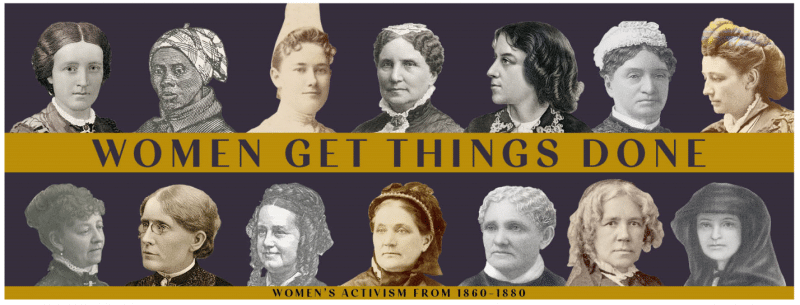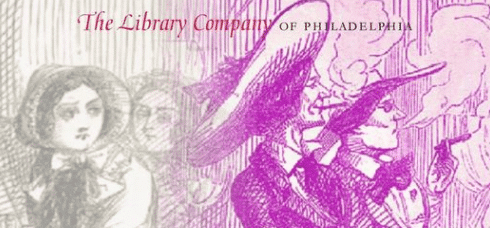Women Get Things Done VIRTUALLY!
Our new exhibition, Women Get Things Done: Women’s Activism from 1860 to 1880, opened in the Library Company’s gallery on September 22nd. Due to COVID restrictions, most viewers have had to explore it virtually: https://librarycompany.org/wgtd. In the show, Curator of Women’s History Cornelia King puts the famous women suffrage activists Elizabeth Cady Stanton and Susan B. Anthony into the context of their now less-well-known contemporaries, many of whom did not agree with the “radical” idea that women should have the right to vote.
In conjunction with the show, we hosted two events on Zoom: a three-night seminar led by Wilkes University professor Amy Sopcak Joseph, and an LGBT History Month lecture by Dr. Megan Springate of the National Park Service (sponsored by the Library Company’s Charlotte Cushman Society).
Amy Sopcak Joseph, a former Library Company fellow, provided an excellent three-part survey (“Debating Woman’s Place in America: 1860-1880”) on shifting ideas about women’s strengths and capabilities in 19th-century America. She particularly drew on her own research on Sarah Josepha Hale, the longtime editor of Godey’s Lady’s Book. Hale and other opinion leaders shaped ideas about 19th-century women’s roles, emphasizing that women were not inferior to men, but rather suited for different areas of activity. Hale and many of her contemporaries did not support woman suffrage. Having collaborated with us during the months of preparation for the exhibition, Dr. Sopcak Joseph invited Cornelia King to engage in a conversation on the selection process for the exhibition. The two discussed the range of material in the show related to women’s occupations, women’s volunteer work during the Civil War (and their expanded opportunities following the war), the women’s club movement, and the cycles or activity and inactivity that set the stage for renewed suffrage activism in the first two decades of the 20th century.
Similarly, Megan Springate in her lecture “From Boston Marriages to the Lavender Menace: Queer Women and the Fight for Suffrage” discussed how the supporters of woman suffrage lived outside the “charmed circle” of then-current gender norms. As a consequence, popular culture depicted women’s rights activists either as masculine (by showing them smoking, wearing ties, etc.) or promiscuous if they “retained” their femininity in dress (and thus adhered to “respectability politics”). Many 19th-century and 20th-century women’s rights activists did in fact flout gender norms and have same-sex partners.
Both speakers made the point that the work for women’s rights is ongoing. The specifics of the “charmed circle” change constantly, redefining what is “queer” – and many of the issues from 19th-century America have sustained resonance today. We were honored to have been able to sponsor the events through The Davida T. Deutsch Program in Women’s History and the Charlotte Cushman Society.
The full recordings for both events are on YouTube:
Debating Woman’s Place in America: 1860-1880
From Boston Marriages to the Lavender Menace: Queer Women and the Fight for Suffrage



